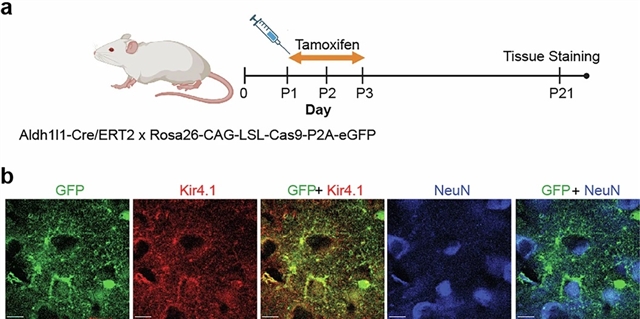
星形胶质细胞的形态发生需要自我识别,这一成果由美国加利福尼亚大学S. Lawrence Zipursky小组经过不懈努力而取得。2025年5月28日出版的《自然》杂志发表了这项成果。
在这里,课题组研究人员报道了γC3, Pcdhγ家族中的一种特异性亚型,在人和小鼠细胞星形胶质细胞中富集。通过基因操作,该课题组证明了γC3自主调节单母视皮层星形胶质细胞的形态发生。为了确定γC3蛋白是否通过促进同一星形胶质细胞进程之间的识别而起作用,研究人员生成了一对对γC3嵌合蛋白,它们能够相互异亲结合,但不能亲和结合。在相同的γC3缺失的星形胶质细胞中,共表达互补的异亲性结合异构体对可以恢复正常形态。相比之下,嵌合γC3蛋白在单个γC3缺失突变星形胶质细胞中单独表达则没有。这些数据表明,γC3介导的自我识别有助于哺乳动物大脑中星形胶质细胞的发育。
据介绍,自我识别是整个进化过程中一个基本的细胞过程,也是神经元自我回避的基础。Clthemtered protocadherin(cPcdh)蛋白,包含一个大的同型特异性同源识别分子家族,在哺乳动物大脑发育所需的神经元自我回避中起着关键作用。不同cPcdh异构体的概率表达赋予神经元独特的身份,并形成神经元过程区分自我和非自我的基础。这种自我识别机制是否也存在于星形胶质细胞中尚不清楚。
附:英文原文
Title: Astrocyte morphogenesis requires self-recognition
Author: Lee, John H., Sergeeva, Alina P., Ahlsn, Gran, Mannepalli, Seetha, Bahna, Fabiana, Goodman, Kerry M., Xu, Runzhe, Khakh, Baljit S., Weiner, Joshua A., Shapiro, Lawrence, Honig, Barry, Zipursky, S. Lawrence
Issue&Volume: 2025-05-28
Abstract: Self-recognition is a fundamental cellular process across evolution and forms the basis of neuronal self-avoidance1,2,3,4. Clustered protocadherin (cPcdh) proteins, which comprise a large family of isoform-specific homophilic recognition molecules, have a pivotal role in the neuronal self-avoidance that is required for mammalian brain development5,6,7. The probabilistic expression of different cPcdh isoforms confers unique identities on neurons and forms the basis for neuronal processes to discriminate between self and non-self5,6,8. Whether this self-recognition mechanism also exists in astrocytes remains unknown. Here we report that γC3, a specific isoform in the Pcdhγ family, is enriched in human and mouse astrocytes. Using genetic manipulation, we demonstrate that γC3 acts autonomously to regulate astrocyte morphogenesis in the mouse visual cortex. To determine whether γC3 proteins act by promoting recognition between processes of the same astrocyte, we generated pairs of γC3 chimeric proteins that are capable of heterophilic binding to each other, but incapable of homophilic binding. Co-expression of complementary heterophilic binding isoform pairs in the same γC3-null astrocyte restored normal morphology. By contrast, chimeric γC3 proteins individually expressed in single γC3-null mutant astrocytes did not. These data establish that self-recognition mediated by γC3 contributes to astrocyte development in the mammalian brain.
DOI: 10.1038/s41586-025-09013-y
Source: https://www.nature.com/articles/s41586-025-09013-y
Nature:《自然》,创刊于1869年。隶属于施普林格·自然出版集团,最新IF:69.504
官方网址:http://www.nature.com/
投稿链接:http://www.nature.com/authors/submit_manuscript.html
